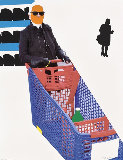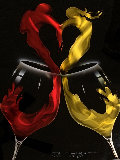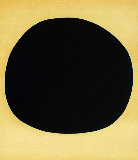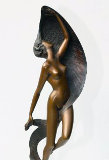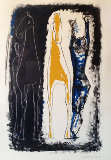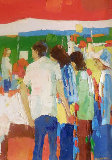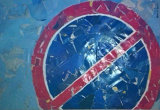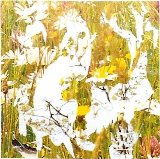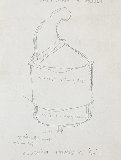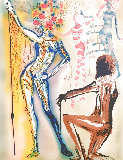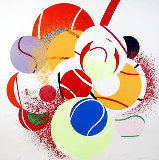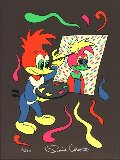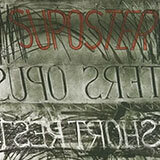


Bianchi E Neri I (Acetates) - Plate F 1969
Alberto Burri
Limited Edition Print : Lithography, Chalcography And Acetate Collage
Size : 19x24.8 in | 48x63 cm
Edition : From the edition of 90
Reduced
-
Framed Mixed Media Lithograph $$$$$$$
Year1969
Hand SignedLower Right in Pencil
Condition Excellent
Purchased fromPrivate Collector 2016
Certificate of AuthenticityArt Brokerage
LID99141
Alberto Burri - Italy
Art Brokerage: Alberto Burri Italian Artist: b. 1915-1995. Alberto Burri was an Italian painter and sculptor. Burri's first paintings were views of the desert he could see from the prison camp and still life with paints and canvases supplied by the YMCA. He primarily painted "nostalgic Umbrian landscapes and figures", as Milton Gendel described in an Art News issue published in 1954. He collected old burlap sacks and brought them with him upon his return to Italy and continued to use them in place of canvas. Burlap, a symbol of the war itself was a cheap and durable material used for tents, supplies, sacks, sandbags and camouflage netting during the war. He continued to use burlap, having a supply from the local miller. For many Italian critics these burlap canvases provided a historical link to international modernism and prewar movements, such as the collage tradition, that could obscure the specificity of Italy's recent fascist past, yet their innovative use of non-art material set them apart, making them symbols of progressiveness of Italian culture. Burri was influenced by his contemporary Enrico Prampolini, whose involvement in Dada and Surrealism shaped Burri's approach to art. Prampolini's use of color, abstraction in painting and techniques in stage-design can be seen markedly in the works that Burri created. Burri had also been attracted to the Italian concept of "poly materialism" or the ability of a single work of art to contain a variety of material effects. In order to push the limitations of a flat painting, Burri travelled to Paris in 1949 to meet artists like Paul Klee, Jean Arp, and Joan Miró. Arp's lifelong experimentation with relief sculpture and painting must have had a lasting impression on Burri who started experimenting with large-scale wall reliefs after his return from Paris. Burri started investigating the use of non-traditional materials such as burlap, wood, tar, plastic, zinc oxide, pumice, kaolin, PVC adhesives, cellotex and fabric in the late 1940s. In the mid-1950s, Burri introduced charred wood into his burlap works, followed by scrap iron sheets fixed onto the wood, as well as colored and transparent sheets of plastic. In the 1970s he began his "cracked" paintings, or cretti. He created a series of works in the industrial insulating material, Celotex, from 1979 through the 1990s. In the 1980s, Burri created a form of land art project on the town of Gibellina in Sicily. The town was abandoned following the 1968 Belice earthquake, with the inhabitants being rehoused in a newly built town 18 km away. Burri covered an area of over 120,000 square metres (1,300,000 sq ft), most of the old town, and an area roughly 300 metres by 400 metres with white concrete.He called this the Grande Cretto. At a Sotheby's London sale of works from a private collection in the north of Italy, Burri's Combustione legno (1957) was auctioned for 3.2 million in 2011. Listings wanted.

